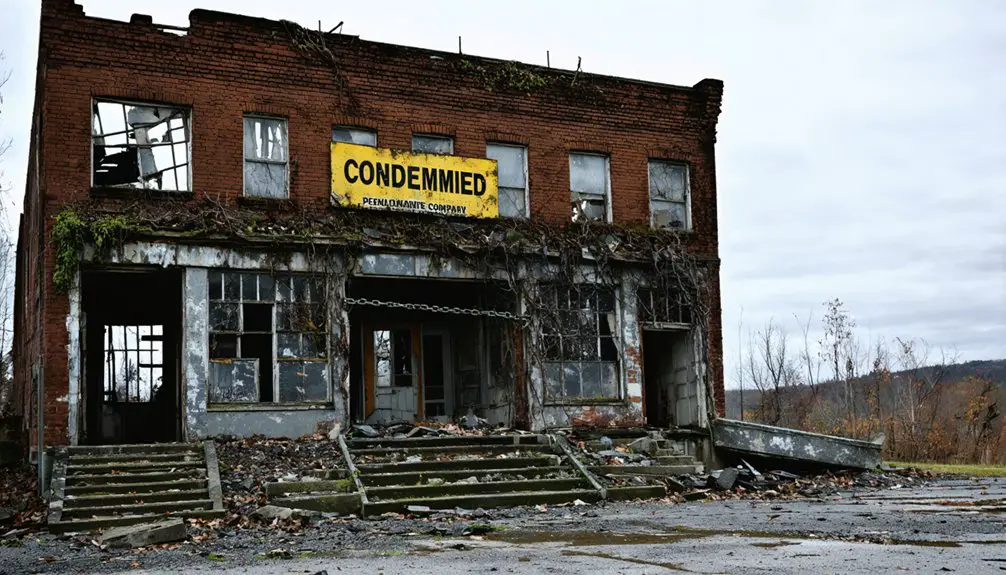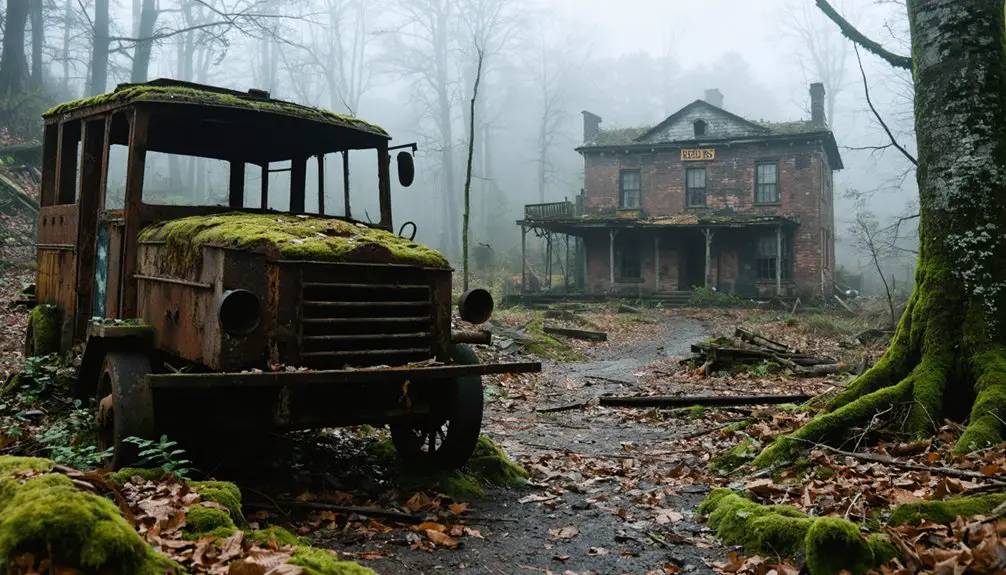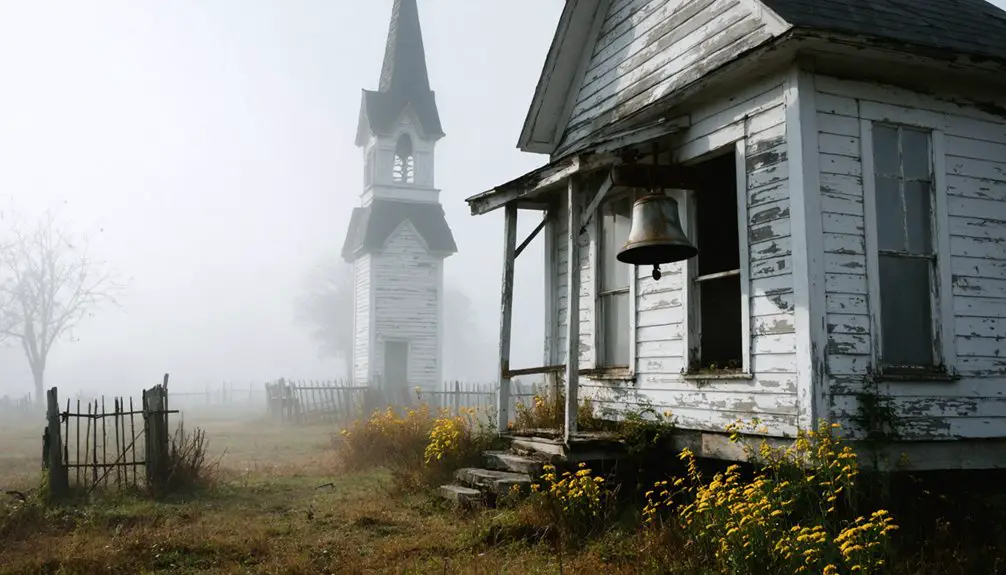You’ll find Reed, Pennsylvania, a ghost town that emerged from a tragic 1962 underground coal fire. Originally settled in 1783 by Thomas Reed, the town grew into a bustling mining community after Jacob Reed began coal operations in 1818. When the fire started, toxic gases and dangerous sinkholes forced evacuations, leading to a $42 million government relocation program. Today, abandoned structures and wild vegetation tell a haunting story of Pennsylvania’s coal mining heritage.
Key Takeaways
- An underground coal fire in 1962 forced the evacuation of Reed, Pennsylvania, transforming it into an abandoned ghost town.
- The community initially resisted relocation but accepted $42 million in federal buyouts by 1983 due to dangerous conditions.
- Toxic gases, sinkholes, and infrastructure damage from the underground fire made the area uninhabitable by 1991.
- Today, Reed features crumbling buildings, abandoned structures, and wild vegetation reclaiming the former mining town.
- The underground fire continues burning, with temperatures exceeding 1,000°F, and could persist for thousands of years.
The Birth of a Mining Community
When Thomas Reed settled the Pennsylvania wilderness in 1783, he laid the foundation for what would become a thriving mining community.
You’ll find the settlement history began with Reed’s simple log cabin and sawmill, marking mankind’s first foothold in this resource-rich region. His son Jacob expanded their presence by launching a mining operation in 1818, though transportation limitations initially held back major development. A key development came when King George III authorized the Kings Highway in 1770, establishing an important transportation route through the area.
From humble cabin to mining beginnings, the Reed family’s frontier outpost gradually grew despite early transportation challenges.
The mining origins truly took off after Necho Allen’s discovery of anthracite coal in 1799, sparking intense interest in the area’s mineral wealth.
As the industrial revolution gained momentum, skilled immigrants from England, Wales, Germany, and Ireland flocked to the growing settlement. The community’s identity formed around coal mining, leading to its official incorporation as Minersville in 1831, a name that proudly declared its industrial heritage. Similar to other mining towns of the era, the region produced impressive quantities of coal, with 2,500 tons daily being shipped from local mines by 1915.
Underground Inferno: The Coal Fire Disaster
If you’d visited Reed in 1962, you’d have witnessed the start of a catastrophic underground fire that began when firefighters lost control of a routine coal refuse burn.
Despite initial attempts to extinguish the flames, costs to control the fire escalated from thirty thousand dollars to over $100,000 within the first year.
As the flames spread through abandoned mine shafts and coal seams beneath the streets, toxic gases and dangerous ground conditions forced residents to confront a growing crisis. The risk was all too familiar to Pennsylvania mining communities, where gas explosions had claimed nearly 2,000 lives between 1878 and 1932.
The situation deteriorated rapidly as sinkholes opened without warning and lethal concentrations of carbon monoxide seeped from ground fissures, ultimately leading to the community’s evacuation.
Fire’s Initial Spread Patterns
Although the Reed coal fire‘s exact origin remains debated, its initial spread pattern stemmed from a municipal landfill atop a strip mine in May 1962. The most widely accepted theory suggests borough workers intentionally ignited trash to reduce volume before Memorial Day, but an incomplete clay barrier allowed the fire ignition to penetrate deeper.
You’ll find the fire’s underground spread was swift and devastating, as it encountered a complex network of abandoned anthracite mines. The blaze moved through these tunnels, feeding on coal seams and reaching temperatures over 1,000°F. Initial efforts to control the disaster through water and hoses proved futile as the fire continued its relentless progression. The thermal insulation of the underground environment meant that the fire could burn for thousands of years without natural extinguishment.
Natural ventilation through mine openings and surface fissures provided oxygen that sustained the smoldering combustion. The fire’s direction followed existing mine layouts and fractures, while flooded mine headings and thinner coal seams to the west acted as natural barriers.
Community Response and Evacuation
Despite mounting evidence of deadly underground fires, Reed’s residents initially met evacuation warnings with fierce resistance in the early stages of the disaster. Community mistrust and emotional attachment to homes fueled defiant responses against government relocation efforts. The town faced sulfuric odors that permeated the air as coal continued to burn underground.
- Residents challenged official safety concerns, claiming the state wanted their land for coal mining.
- Carbon monoxide incidents, including people passing out in their homes, proved the dangers were real.
- Legal battles ensued when homeowners refused generous compensation packages.
Congress passed a $42 million bill to assist with relocating affected residents, though many still refused to leave.
– Infrastructure damage and lethal gas concentrations finally forced mandatory evacuations by 2012.
You’ll find this standoff reflected deep cultural bonds and skepticism of authority, even as toxic gases seeped through ground fractures and structures deteriorated.
The state’s threats of eminent domain ultimately prevailed over residents’ resistance, though some continued filing unsuccessful lawsuits alleging fraudulent government motives.
Daily Life in Peak Coal Years
While coal mining brought employment to Reed, Pennsylvania, the harsh reality of daily life during the peak coal years revealed a community shaped by grueling work conditions and stark poverty.
Coal mining may have fueled Reed’s economy, but its workers paid dearly through backbreaking labor and desperate living conditions.
You’d find children as young as nine working as nippers, drivers, and breaker boys in the mines, while living in cramped company-owned huts with their families. Living conditions were squalid, with poor sanitation and high rents despite the substandard housing. The streets were filthy and neglected, with iron dust and waste covering the unpaved roads. Some desperate parents would even forge work documents to get their children jobs in the mines.
Your options for recreation would’ve been limited to beer-shops, with few cultural activities available.
If you were a miner, you’d face deep coal seams and exhausting physical labor while earning wages that hadn’t increased since the 1870s. To survive, your entire family, including children, would likely need to work in mining-related jobs, sacrificing education and leisure for economic stability.
When the Ground Began to Give Way
You’d first notice the subtle cracking in your home’s foundation and the strange tilting of floors – telltale signs that the abandoned coal mines beneath Reed were finally giving way.
Your neighbors would whisper about hearing old mining equipment sounds underground, while watching helplessly as toxic sinkholes began swallowing streets and threatening homes.
The combination of earlier “room and pillar” mining practices and later companies extracting support pillars had created vast unstable voids beneath the town, leading to widespread subsidence that would eventually force residents to abandon their properties.
Sudden Sinkholes Strike Homes
In the early months of 1952, just as H.C. Frick Coke Co. abandoned the Marguerite Mine, residents noticed the first signs of impending danger.
You’d find evidence of sinkhole formation through subtle ground movements, with some areas sagging half an inch yearly.
But it’s the sudden collapses that transformed Reed forever.
- Teardrop-shaped cavities opened without warning, swallowing homes whole
- Underground voids, lying just 20 feet below ground, catastrophically failed
- Old mine tunnels, filled with air or water, provided zero structural support
- Buried infrastructure and decomposing materials accelerated the collapses
When these sinkholes struck, you’d have mere moments to escape.
The clay-rich soil would suddenly give way, creating cover-collapse sinkholes that devoured everything above.
Many families lost their homes to these unpredictable ground failures, forcing them to abandon their properties forever.
Toxic Earth Claims Streets
The sinkholes weren’t Reed’s only nemesis during its decline. You’ll find the ground itself turned hostile as oil and gas companies exploited a regulatory loophole, spreading toxic wastewater across rural roads.
This practice saturated Reed’s soil with dangerous levels of radium and chemical contaminants, creating a perfect storm of toxic exposure.
The earth beneath residents’ feet began deteriorating as radioactive contamination seeped into the ground, with total dissolved solids reaching 21,000 mg/L – far above Pennsylvania’s 500 mg/L standard.
You couldn’t escape the consequences: contaminated wells forced families to rely on delivered water, while streams used by livestock became poisoned with radioactive elements.
The Pennsylvania DEP’s weak enforcement left Reed’s citizens vulnerable as their streets literally dissolved under waves of unregulated wastewater dumping.
The Mass Exodus and Government Intervention

Following an underground coal fire‘s ignition in 1962, Reed’s community faced a devastating crisis that would ultimately lead to its complete abandonment.
The town quickly descended into community conflict as residents split between those seeking to stay and those demanding relocation. You’d have witnessed neighbors turning against each other, with tensions escalating into violent confrontations and threats.
A community torn apart, as neighbors became enemies over the decision to stay or flee their burning homes.
- Federal government allocated $42 million for property buyouts in 1983
- Most residents accepted fair market value offers and relocated
- By 1991, the town stood largely abandoned
- Pennsylvania enforced eminent domain in 1992 on remaining properties
The government’s intervention through buyout programs provided an escape route for many, though some residents fought against relocation until the 2010s, believing in conspiracy theories about coal exploitation.
What Remains: A Town Frozen in Time
Modern-day Reed stands as a haunting indication of nature’s reclamation, where crumbling infrastructure and wild vegetation create an eerie landscape frozen in time.
You’ll find just a handful of abandoned structures still standing, including a lone rowhouse supported by brick buttresses and the municipal building near the town center. The churches – St. Mary’s and St. Ignatius – remain as cultural anchors in the desolate landscape.
Where homes once stood, you’ll now see butterflies dancing among wildflowers and turkeys wandering freely.
Nature’s takeover is evident in the new growth forests and conservation apple trees sprouting from former housing lots. Despite the toxic underground fire that continues to burn, releasing steam through metal vents, life persists above ground, transforming Reed into an unexpected sanctuary of natural rebirth.
Legacy of Reed in Pennsylvania’s Coal Region

Deeply woven into Pennsylvania’s bituminous coal mining heritage, Reed emerged as an essential component of the region’s industrial might during the late 19th and early 20th centuries.
Reed’s economy thrived as part of Indiana County’s expansive coal and coke network, supplying critical resources to regional railroads and steel plants.
- Miners faced intense labor struggles, participating in significant strikes between 1925-1928
- Local mines, including the nearby Big Soldier operation, provided primary employment
- The town’s fortunes rose and fell with industrial coal demand
- Violence and robberies around payroll transport highlighted the era’s lawless nature
You’ll find Reed’s legacy preserved in the broader story of Pennsylvania’s coal communities, where economic consolidation and shifting markets eventually led to the decline of these once-bustling mining towns.
Frequently Asked Questions
What Happened to the Pets and Livestock During the Town’s Evacuation?
You’d be heartbroken seeing massive pet abandonment as families fled, while livestock’s fate turned grim. Many pets roamed wild or perished, and farmers couldn’t transport their large animals to safety.
Are There Any Surviving Photographs of Reed During Its Prosperous Years?
You won’t find any confirmed surviving photographs of Reed in public visual archives or historic documentation. While photos may exist in private collections, they haven’t been discovered or digitally preserved.
How Did Local Native American Tribes View the Area Before Mining?
Ever wonder about life before mines scarred the earth? You’ll find the Susquehannocks viewed this land as sacred, using it for traditional practices like fishing, hunting, and spiritual ceremonies, recognizing its deep cultural significance.
Did Any Businesses Successfully Relocate to Nearby Towns After Abandoning Reed?
You’ll find only one confirmed business relocation from Reed: the Reed Smith law firm moved to Three PNC Plaza in Pittsburgh. There’s no evidence other businesses successfully shifted to nearby communities.
What Natural Wildlife Has Returned to the Abandoned Town Site?
You’ll find increasing wildlife sightings of river otters, beavers, and various bird species in the area. The ecological recovery has created thriving wetland habitats supporting small mammals and aquatic life.
References
- https://www.islands.com/1824527/america-burning-ghost-town-once-thriving-quintessential-mining-destination-pennsylvania-centralia-fire/
- https://pabucketlist.com/the-rise-and-fall-of-centralia-pas-toxic-ghost-town/
- https://www.youtube.com/watch?v=Qj5LjacccJ0
- https://www.pa.gov/agencies/dcnr/recreation/where-to-go/state-parks/find-a-park/reeds-gap-state-park/history.html
- https://uncoveringpa.com/visiting-centralia
- https://chicora.org/pdfs/RS6 – Reed Gold Mine.pdf
- https://minersvillepa.gov/community/history/
- https://www.iup.edu/library/departments/archives/coal/mines-and-company-towns/clymer-looking-back.html
- https://www.slideshare.net/slideshow/history-of-minersville-pa/27942737
- https://www.iup.edu/library/departments/archives/coal/mining-history/history-of-coke.html



